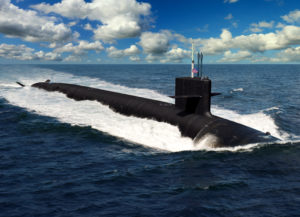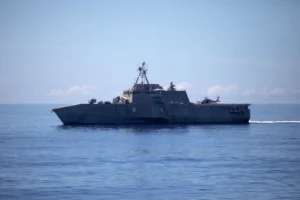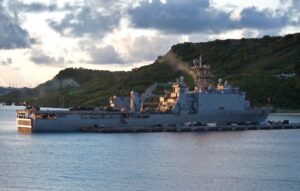The Navy’s fiscal year 2024 budget request, whose details were released Monday, seeks $255.8 billion overall, with $32.8 billion of that devoted to procuring nine battle force ships and $17 billion to buy 88 aircraft.
Speaking to reporters Friday ahead of the detailed budget roll out, Rear Adm. John Gumbleton, Deputy Assistant Secretary of the Navy for budget, said these levels are 4.5 percent, or $11 billion more than the enacted FY ‘23 budget passed by Congress. The Navy procurement account amounts to a 6.4 percent increase over the enacted FY 2023 levels.
In FY ‘24, the Navy is requesting funds to buy the second
Columbia-class ballistic missile submarine (SSBN), two Block V Virginia-class attack submarines (SSN), two Constellation-class frigates, one John Lewis-class oilers and one submarine tender replacement (AS(X)) for a total cost of 32.8 billion.

Other new ship construction under that total includes the service life extension of one older LCAC-01 class hovercraft connector, two LCU-1700 class connectors and two used auxiliary sealift vessels. The budget requests no new LCAC-100 class Ship-to-Shore Connectors after the final FY ‘23 budget provides funds for five more vessels. However, the Navy plans to buy two per year from 2025-2028.
Over the five-year Future Years Defense Program (FYDP) plans, Navy ship procurement plans to maintain a pace of two destroyers and attack submarines per year; maintain the planned pace of alternating one and two frigates per year; a new Columbia-class SSBN every year except FY ‘25; adds the next America-class amphibious assault ship in FY ‘27; and ramps up production on the new Landing Ship Medium, previously called the Light Amphibious Warship, with one each in FY ‘25 and ‘26 and two each in FY ‘27 and ‘28.
The service also plans to procure two more John Lewis-class oilers in FY ‘26 and one each in FY ‘27 and ‘28; one Next Generation Logistics Ship each year from 2026-2028; and one Auxiliary General Ocean Surveillance Ship (T-AGOS(X)) per year from FY 2025 to 2028.
At the end of the five-year future years defense program (FYDP) the Navy plans to have bought four Columbia-class SSBNs, one Ford-class aircraft carrier, 10 attack submarines, 10 destroyers, eight frigates, one America-class amphibious assault ship, six new Landing Ship Medium (LSM) amphibious vessels, six oilers, three next-generation logistics ships, two AS(X)s, and four next-generation Auxiliary General Ocean Surveillance Ship (T-AGOS(X)) .
Notably, the Navy’s budget requests include no plans to procure any San Antonio-class (LPD) amphibious transport dock ships.
Speaking to reporters on Friday, Navy Under Secretary Erik Raven noted the LHA in the FYDP was accelerated into 2027, but the Navy is maintaining a “strategic pause” on other amphibious ships to make sure “that on the acquisition track that we’re looking at the right capabilities for amphibs and that we’re going to procure them in the right way. And so we’re continuing to look at that.”
Gumbleton added since LPDs are most efficiently bought in two-year increments and funding for LPD-32 was given in FY ‘23 and it is not yet on contract, the Navy has until 2025 at the latest to buy another LPD-like ship.

Beyond new construction, the Navy is again seeking to retire several Littoral Combat Ships, Ticonderoga-class cruisers, and amphibious dock landing ships, including the USS Cowpens (CG-63), USS Shiloh (CG-67), USS Vicksburg (CG-69), USS Germantown (LSD-42), USS Gunston Hall (LSD-44), USS Tortuga (LSD-46), USS Jackson (LCS-6), and the USS Montgomery (LCS-8).
If approved, the cruisers and LSDs would be retired two to five years earlier than their 35- and 40-year expected end of service life age. However, the two LCSs would be retired 16-17 years early due to the Navy redirecting the anti-submarine mission of some LCSs to the upcoming new frigate.
Raven told reporters the divestment list was the result of a “ship-by-ship review, to understand the material state of each of the ships.”
He noted the LSDs in particular are “challenged in terms of readiness. We want to make sure that the capabilities that we field are the right capabilities and are able to perform the mission to the standards that we expect. And so we’re proposing those divestments because we think the return on investment on further investments on those particular ships, adjust hull by hull, the return on investment is not there.”
Notably, the Navy tried retiring CG-69, LSD-42, LSD-44 and LSD-46 last year, but Congress prohibited their divestment this year.
While the Navy did not say what would happen to the two Littoral Combat Ships, LCS-6 and LCS-8, it has not ruled out selling them to allies or partners.
Gumbleton told reporters “the department is looking into exactly what we might be able to do with selling LCS. The particular decision for the six and eight call was not about, you know, we’re going to sell these, but the department is looking at that strategy for vessels that we’ve already decommissioned, and that may consider in the future.”

The Navy also noted this budget request includes advance procurement funding for four other Virginia-class submarines as well as economic order quantity funding for future multiyear procurement set to start in FY ‘25. On destroyers, the budget also accounts for economic order quantity funds for a planned multiyear procurement of ships lasting from FY ‘24 to 2027.
Separately, the budget requests $17.3 billion for 88 various aircraft including 19 F-35Cs; 16 F-35Bs; 14 multi-engine training system aircraft for the Navy; 12 for the Air Force; two KC-130J Super Tankers; 15 CH-53K King Stallion helicopters for Marine Corps expeditionary heavy lift assault transport; two unmanned MQ-4C Triton aircraft for persistent intelligence, surveillance and reconnaissance (ISR); three MQ-25 unmanned carrier-based aerial refueling tankers, and five MQ-9A Marine Corps Medium-Altitude Long Endurance (MALE-T) UASs for stand-off sensing and C4 capabilities.
These aircraft procurements will complete the planned total program buys of the KC-130J, MQ-4C and MQ-9A. Likewise, the Navy is not requesting any more F/A-18E/F Super Hornets, E-2D Advanced Hawkeyes, TH-73A trainer helicopters, CMV-22 Ospreys or MV-22B Ospreys, having finished their production with final program procurements in FY ‘23.